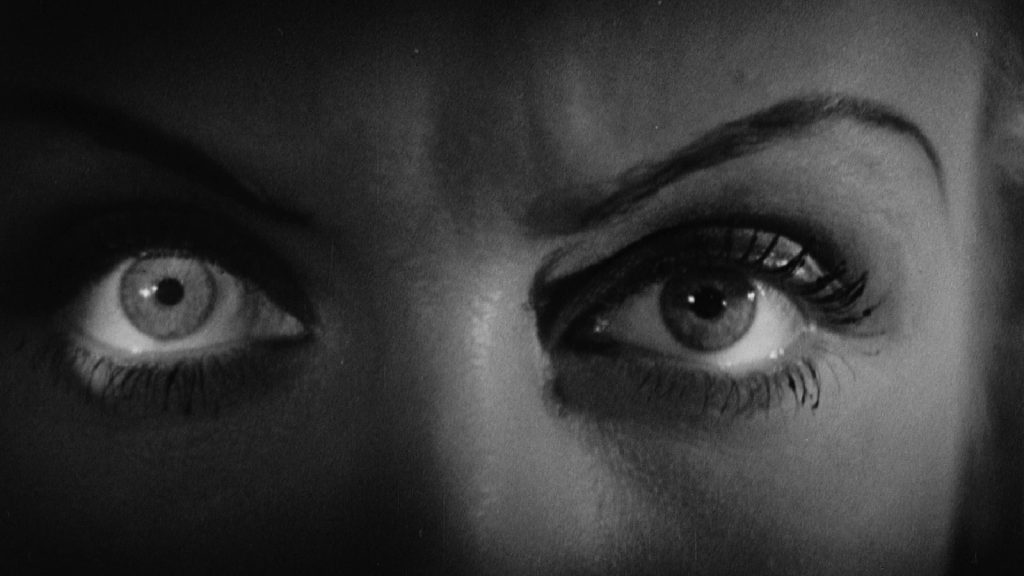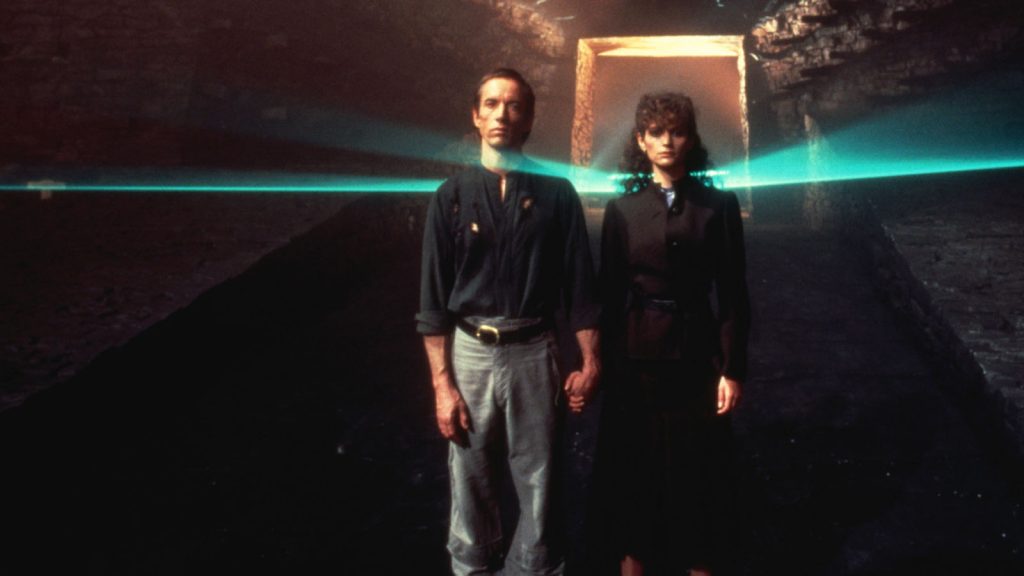
Marie Belloc Lowndes’s 1913 novel The Lodger—an expansion of her short story of the same name—has been an enticing proposition for filmmakers, and well it should, given its delectable “what-if” premise: Jack the Ripper had to have lived somewhere, allowing that he was not unhoused, so what if he lived in the spare room you were renting out? Except maybe it wasn’t him? Who knows! Can I get the rent? Don’t slit my throat!
The novel is the embodiment of pulp; sparks may catch between your fingers because of how fast you’re turning those pages. Hitchcock crafted a silent adaptation of the book in 1927 that demands a place alongside The Lady Vanishes and Rear Window among his finest pictures, which makes sense, given that The Lodger: A Story of the London Fog was Hitchcockian before even Hitchcock was.
Ivor Novello played the Ripper figure in both the Hitchcock silent and the less successful initial sound treatment of The Lodger in 1930, under the direction of Maurice Elvey. The story then lay dormant—cinematically anyway—until 1944, when German filmmaker John Brahm turned the light back on in that proverbial London garret.
The 1940s is tantamount to the lost decade of horror history. It’s the 10-year span of diversification. We have sequels of films from the 1930s, monster rallies for the first time, horror with science overtones that isn’t quite sci-fi/horror, mystery horror, ghost stories, human horror, historical horror, and psychological horror. A lot of ground is covered between the likes of Frankenstein Meets the Wolf Man, The Scarlet Claw, The Uninvited, and The Curse of the Cat People.
Brahm’s film checks a number of those categorical boxes, and just because a person might not know about it doesn’t mean it isn’t a classic and one of the standouts of what is a sleeper candidate for the finest horror decade. Brahm had true talent. People who know their horror stuff dig him, much like noir people—and, come to think of it, horror people as well—are into Jacques Tourneur. Brahm was a pro’s pro who was simultaneously identifiable as an auteur. There aren’t many directors in this mold. They’re able to move from genre to genre and medium to medium, and no matter the picture—or the television show (Brahm directed many episodes of The Twilight Zone, including 1960’s “Mirror Image,” which may be the series’ scariest)—you know it’s them. Insofar as they have a style—because they’re not limited to a type of composition, photographic technique, backdrop, or characterization—it’s this.

Brahm excelled at melodrama—costume pictures that didn’t look ostentatious but nailed the period details. Enter, then, The Lodger and its Victorian London of fog, soot, flagstones, ulsters, and labyrinthine mews with a gas lamp on one end and who knows what awaiting at the other. Anyone at the right time of night could have been Jack the Ripper to the susceptible imagination. And if that’s him upstairs? Not the easiest subject to broach. “Excuse me, sir, but do you happen to know your way around a scalpel in a less than healing sort of manner?”
Brahm also had an outstanding actor in the Ripper role: Laird Cregar. Treasure every film in which Cregar appears, because there aren’t many. He died in 1944 at 31 (he seemed both so much older in his films and beyond the laws of aging; chronologically unplaceable), after starring in another stellar Brahm film, Hangover Square. A big man, Cregar was ever supple and catlike on screen, with the voice to match. We don’t think of Jack the Ripper as stocky, but after watching The Lodger, we’re apt to summon Cregar’s characterization to mind when the subject of history’s most famous murder comes up. Looking the preconceived part, as determined by our expectations, is not the same as embodying the thing, as Cregar’s performance—and his Ripper-ness—attests.
We are always on our guard in The Lodger. There’s no such thing as a red herring here. We’re all trying to figure out who this guy is and what to do about it. And if Cregar’s towering performance wasn’t enough, you get George Sanders as a detective. Normally, Sanders portrays a cad, the quintessence of insouciance and what would otherwise register as class and sophistication if he didn’t cause people to think, “What the hell is this shifty guy up to?” But in The Lodger, the Sanders persona is “out-shifted” by the enigma—and potential devil of a problem—in the room upstairs.
Merle Oberon plays the lodger’s love interest—because he’s got to fixate on someone, hasn’t he?—and let’s just say that boy definitely doesn’t get girl, at least not in the manner we usually mean. The Lodger is intense, grisly, mysterious, evocative, subtle, in your face—and yet shadowy—and gripping for every second of its run time. The definitive work of Ripper-related art that also serves as its own self-contained dark treasure. Stay in to watch it and you remain safe—dependent, of course, on who boards with you. 🩸

is the author of eight books, including the story collection, If You [ ]: Fabula, Fantasy, F**kery, Hope, a 33 1/3 volume on Sam Cooke’s Live at the Harlem Square Club, 1963, Meatheads Say the Realest Things: A Satirical (Short) Novel of the Last Bro, and a book about 1951’s Scrooge as the ultimate horror film. His work has appeared in Harper’s, The Atlantic, Rolling Stone, The New York Times, Vanity Fair, The Daily Beast, Cineaste, Film Comment, Sight and Sound, JazzTimes, The New Yorker, The Guardian, and many other venues. He’s completing a book called And the Skin Was Gone: Essays on Works of Horror Art. His website is colinfleminglit.com, where he maintains the Many Moments More journal, which, at 2.7 million words and counting as of autumn 2023, is the longest sustained work of literature in history.
People who peruse vintage TV programming schedules are used to seeing horror movies billed as something other than “horror,” as if the term was to be avoided whenever possible.
BY COLIN FLEMING | October 24, 2024
One of the most beloved horror movies of the 1940s that didn’t have the name Val Lewton attached to it, Paramount’s The Uninvited is a classy, atmospheric chiller...
BY MICHAEL KORESKY | October 31, 2021
At this crazy moment, when film history is caught in the grip of multiple clichés that grind on and on and on...
BY KENT JONES | September 10, 2023

This pre-Code offering packs a lot of story into its typically brisk running time, with several plot threads weaving together a (not always successful) tapestry of spooky and criminal doings.
READ MORE >
BY ANN OLSSON | Month 00, 2021

In what could be the fastest-resulting rape revenge movie, a drunken lout brutally forces himself on Ida, the young woman who doesn't return his affections, during a party over Labor Day.
READ MORE >
BY LAURA KERN | Month 00, 2021

Beast is a lot of movies in one package - fractured fairy tale, belated-coming-of-age story, psychological drama, regional horror film - but above all it's a calling card for its leading lady, Jessie Buckley.
READ MORE >
BY LAURA KERN | Month 00, 2021